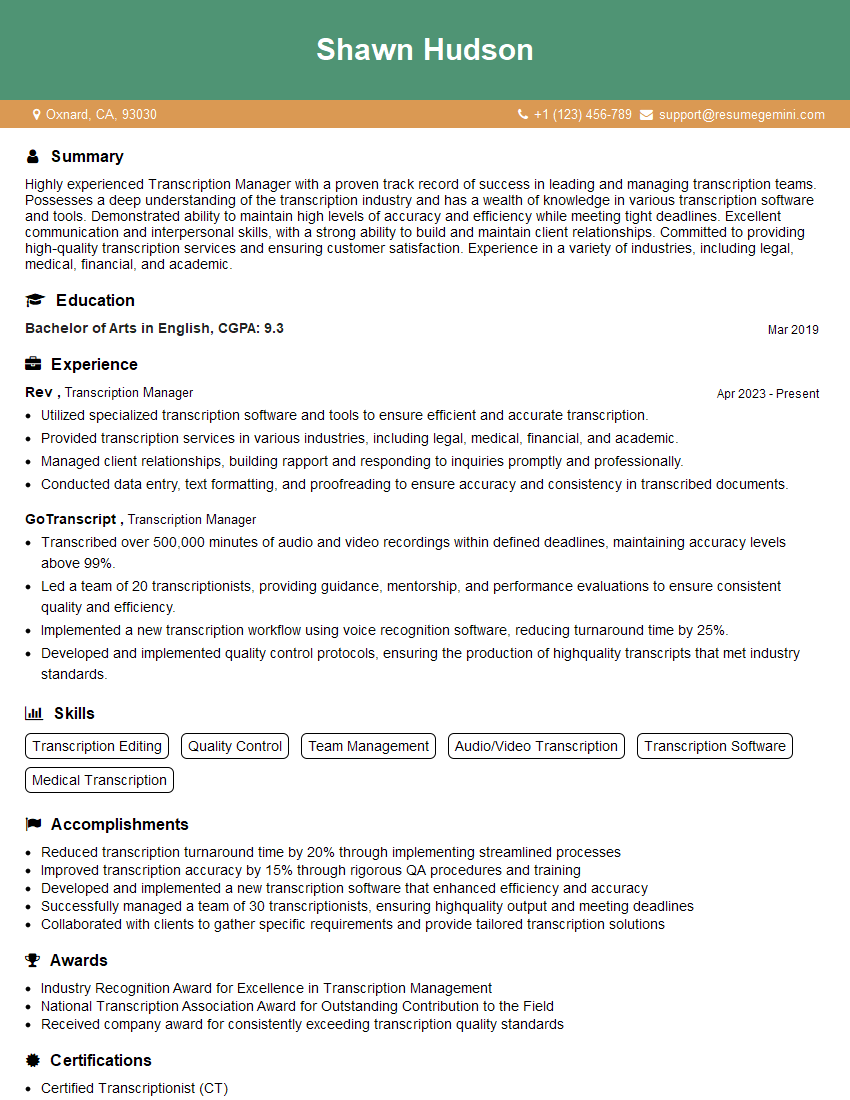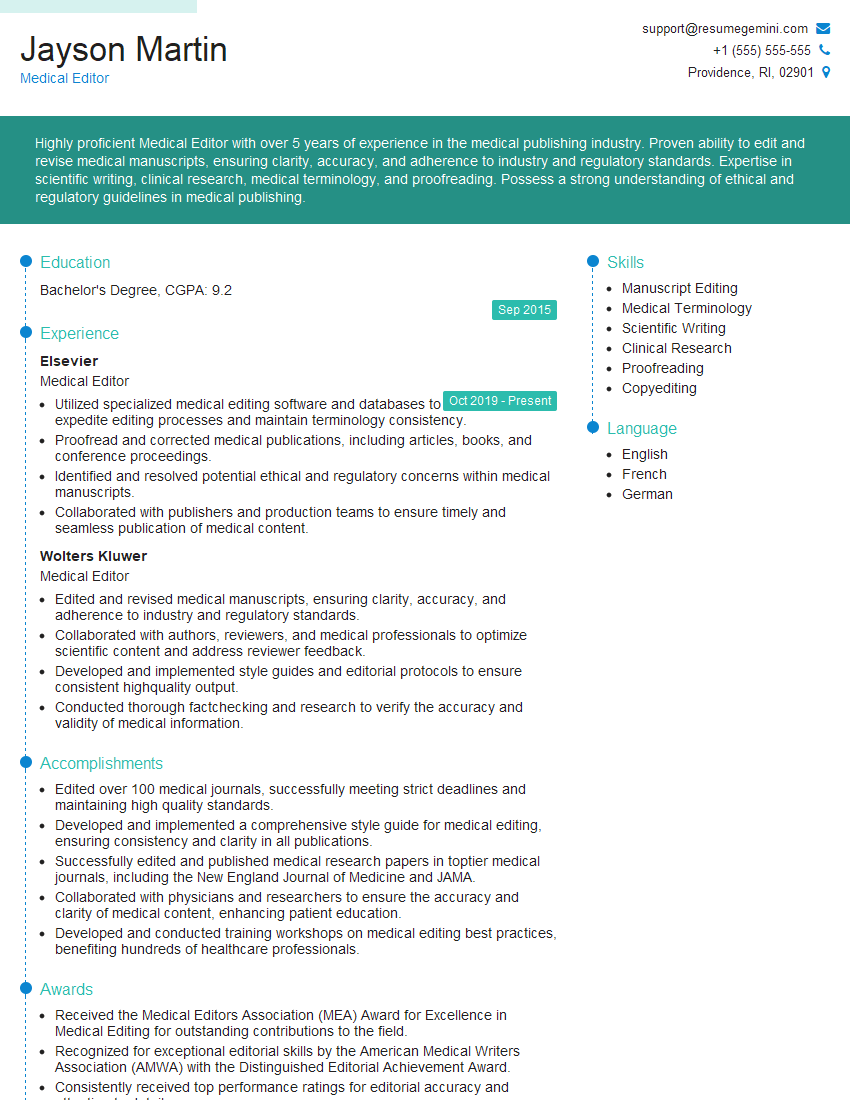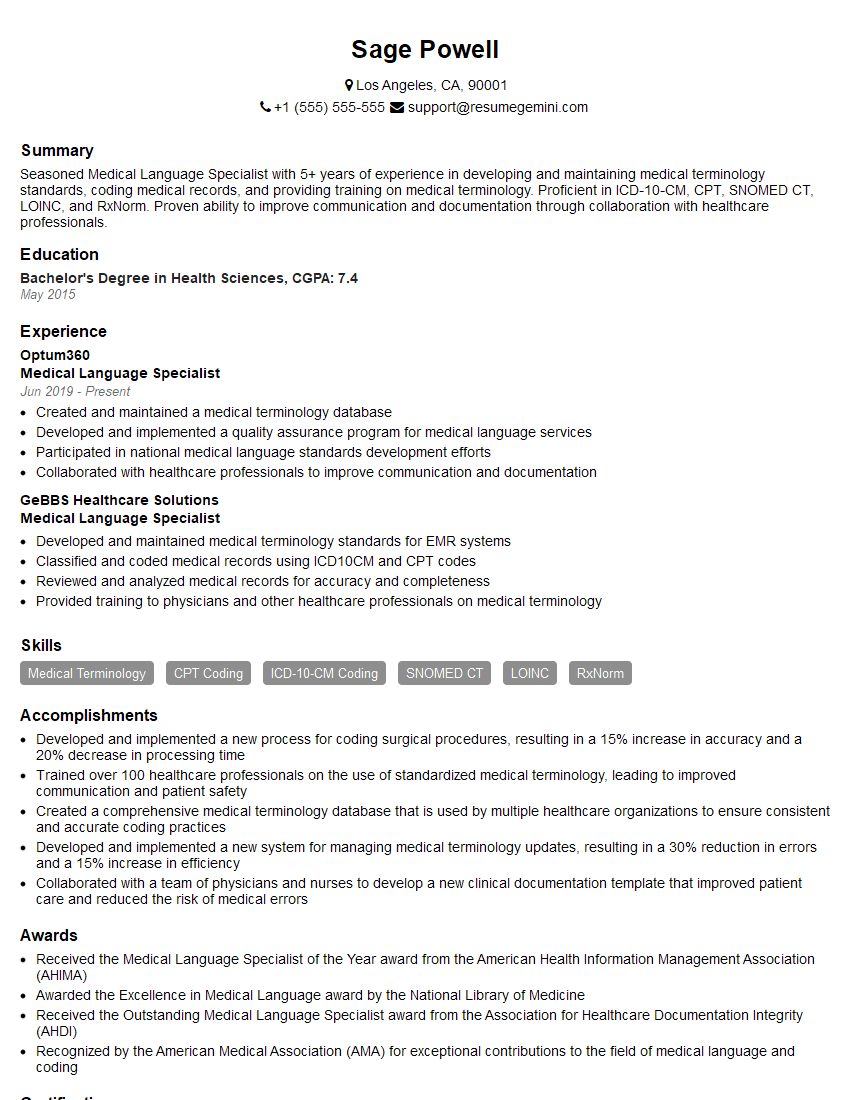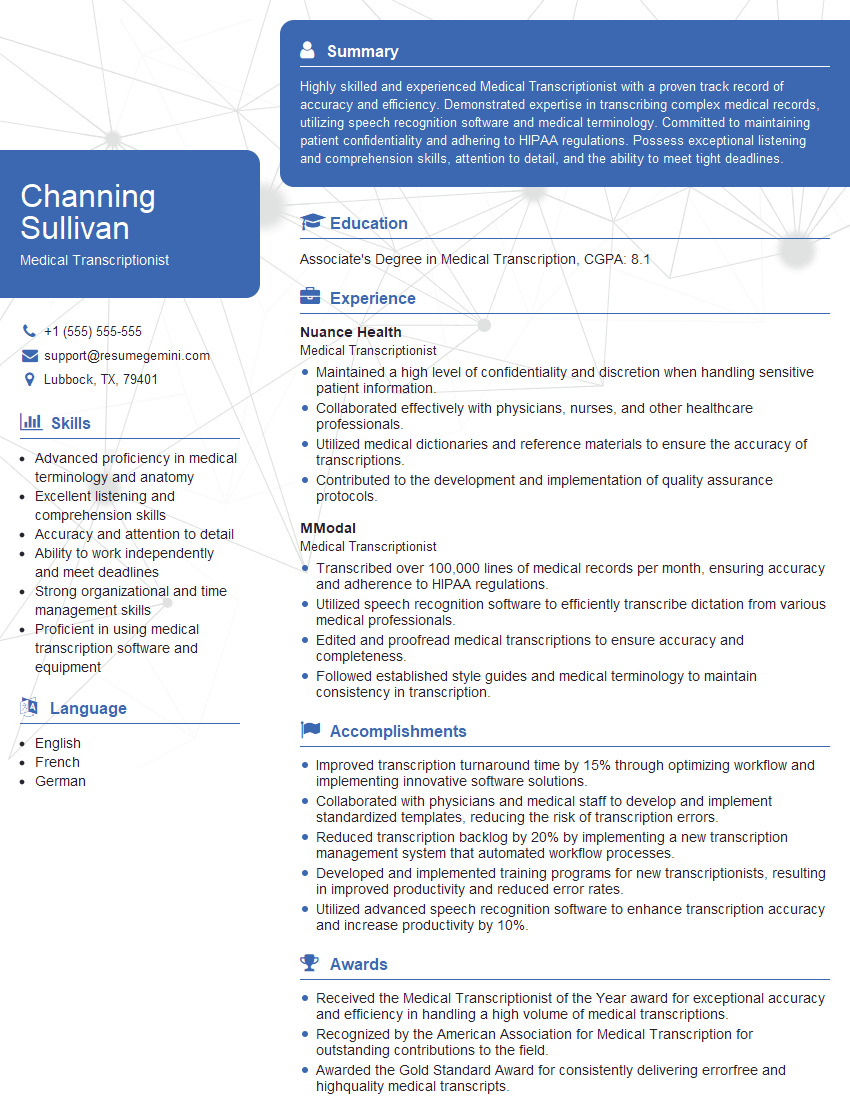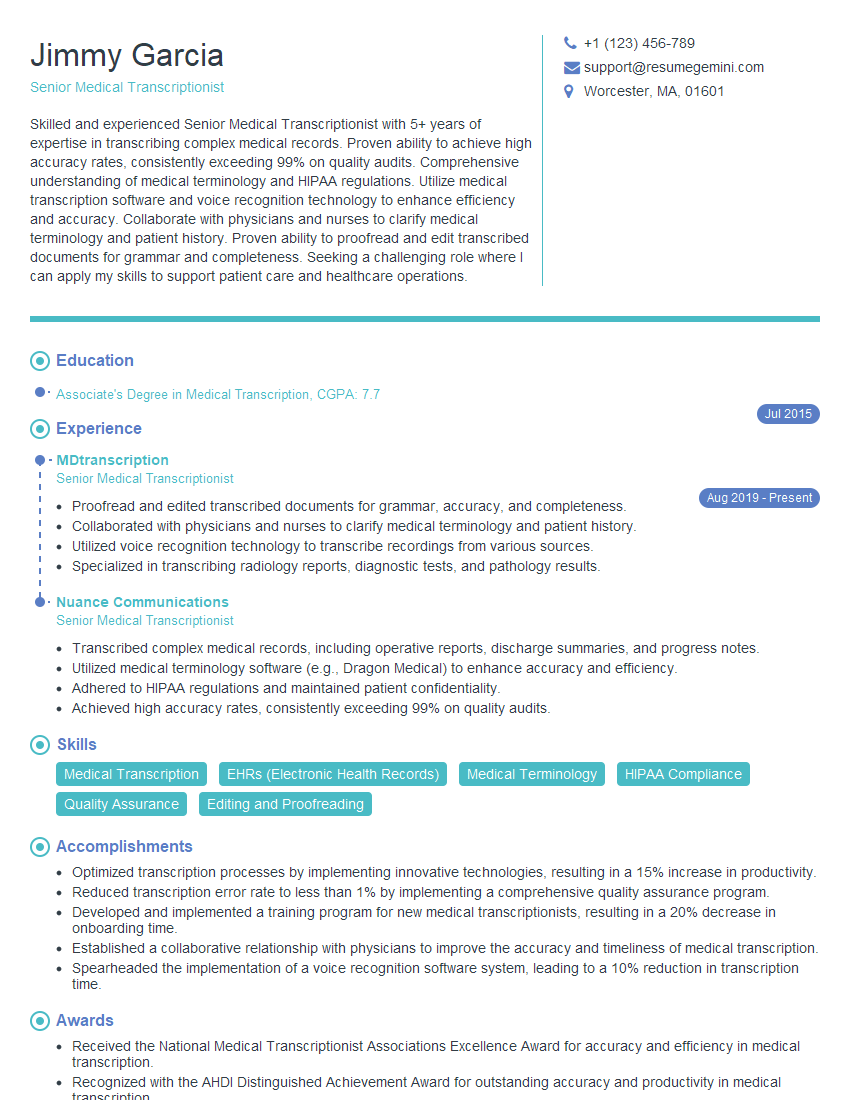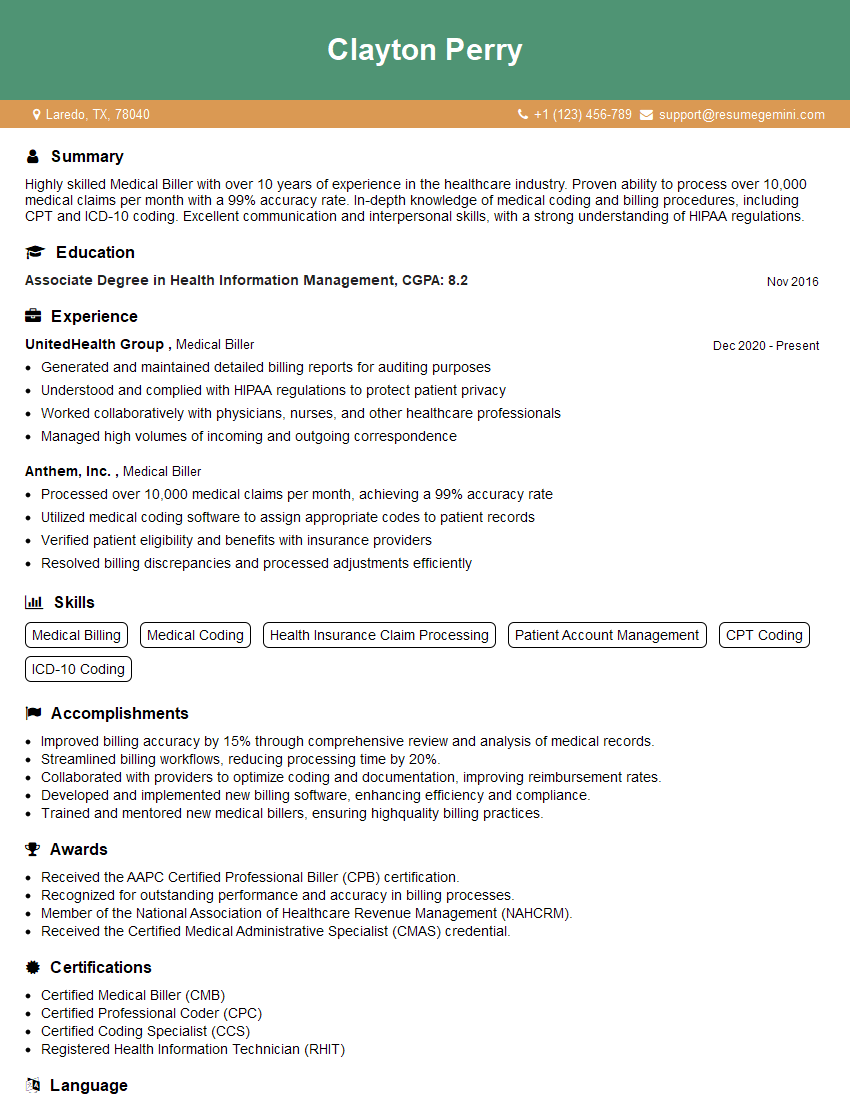Unlock your full potential by mastering the most common MT Certification interview questions. This blog offers a deep dive into the critical topics, ensuring you’re not only prepared to answer but to excel. With these insights, you’ll approach your interview with clarity and confidence.
Questions Asked in MT Certification Interview
Q 1. Explain the importance of accurate medical transcription.
Accurate medical transcription is paramount because it forms the cornerstone of a patient’s medical record. Inaccurate transcription can lead to misdiagnosis, inappropriate treatment, medical errors, and even legal ramifications. Think of it like this: the medical record is the story of a patient’s health journey, and the transcriptionist is the meticulous editor ensuring the story is accurate and complete. Every detail, from medication dosages to procedural notes, must be precise. A single misplaced decimal point in a medication dosage, for example, could have devastating consequences. Accurate transcription ensures the seamless flow of information between healthcare professionals, ultimately improving patient care and safety.
Q 2. Describe your experience with different medical dictation formats.
Throughout my career, I’ve worked with a variety of dictation formats, including dictated reports, dictated operative notes, radiology reports, and pathology reports. I’m proficient in handling both template-based dictations, where physicians utilize pre-set structures, and free-style dictations, which require more interpretive skills. I’m comfortable with different levels of detail and terminology used by various specialists, from cardiologists who utilize complex cardiac terminology to dermatologists who detail skin lesions with intricate descriptions. I am also experienced in handling dictations from both voice recognition software and traditional audio recordings.
For instance, I’ve successfully transcribed complex surgical notes using specific anatomical terminology and precise descriptions of surgical techniques. In other cases, I’ve worked with less structured dictations focusing more on patient history, where understanding the clinical context is crucial for accurate interpretation. My experience allows me to quickly adapt to different physician styles and dictation formats.
Q 3. How do you handle ambiguous or unclear dictation?
When faced with ambiguous or unclear dictation, my approach is methodical and prioritizes accuracy and patient safety. First, I carefully review the surrounding context within the report to clarify the meaning. If the ambiguity persists, I employ several strategies: I might consult medical dictionaries and resources, or use online medical terminology databases to find definitions of unfamiliar terms or abbreviations. If the issue is a missing piece of information, I’ll flag it for clarification from the dictating physician. This could involve a simple query sent through a secure messaging system. Documenting these queries and the clarifications received is critical for maintaining a complete and accurate record.
For example, if a physician mentions an ‘irregularity’ without further specification, I will carefully review the entire report to determine the context. If I cannot deduce its meaning, I will clearly flag this to the physician, with the appropriate wording, for clarification. The patient’s safety is always my top priority.
Q 4. What software and hardware are you proficient with for medical transcription?
My proficiency extends to a range of software and hardware commonly used in medical transcription. I’m adept at using transcription software such as Nuance PowerScribe and M*Modal Fluency, familiar with various audio playback systems, and skilled in using foot pedals for efficient navigation and playback control. My hardware experience includes working with both digital and analog dictation systems, understanding the specifics of handling different audio file formats and troubleshooting playback issues. Furthermore, I’m proficient in using electronic health record (EHR) systems to upload and manage completed transcriptions.
Q 5. Explain your process for quality control and proofreading.
Quality control and proofreading are integral parts of my workflow. My process involves a multi-step approach: first, I ensure the accuracy of all medical terminology, spelling, grammar, and punctuation. Then I verify the numerical data, such as dosages and measurements, for precision. I then carefully review the report for inconsistencies or missing information before finalizing it. Finally, I conduct a thorough review to ensure the document is compliant with all relevant regulations and formatting guidelines. This often involves a second proofread, sometimes using different software tools that assist in flagging potential errors. For example, I will use a spell-checker for medical terms in addition to my own careful reading. The goal is always to deliver a clean, accurate, and compliant document.
Q 6. How do you manage your time effectively during high-volume periods?
Managing time effectively during high-volume periods is crucial. My strategy involves prioritizing tasks based on urgency and complexity, using time management techniques like setting deadlines and utilizing productivity tools. I break down large transcription jobs into smaller, manageable chunks, focusing on one task at a time and taking short breaks to maintain concentration and prevent burnout. Batching similar types of reports together can also be efficient. For instance, I might focus on transcribing all the dictated operative notes first before moving onto the consultation notes. Prioritization and efficient workflow are key to managing heavy workloads.
Q 7. Describe your knowledge of medical terminology, anatomy, and physiology.
My knowledge of medical terminology, anatomy, and physiology is extensive. Years of experience have provided me with a deep understanding of medical prefixes, suffixes, and root words, enabling me to accurately decipher complex medical jargon. I possess a solid grasp of anatomical structures and their functions, and I regularly consult reputable medical resources to keep my knowledge current. For example, I understand the differences between various types of fractures and can transcribe complex surgical procedures with anatomical precision. This deep understanding helps ensure the accuracy of my work, particularly when encountering unfamiliar or uncommon medical conditions or procedures. Ongoing professional development and continuous learning are integral to maintaining this expertise.
Q 8. How do you stay updated with changes in medical terminology and healthcare regulations?
Staying current in the dynamic fields of medical terminology and healthcare regulations requires a multi-pronged approach. Think of it like constantly updating a medical dictionary and legal codebook simultaneously.
- Professional Organizations: I actively participate in professional organizations like AHIMA (American Health Information Management Association) and AAMT (American Association of Medical Transcriptionists). Their journals, webinars, and conferences offer invaluable insights into the latest updates and best practices. For example, AHIMA regularly publishes updates on ICD-10 coding changes and HIPAA compliance regulations.
- Continuing Education: I dedicate time to completing continuing education courses focused on medical terminology, coding, and compliance. These courses often cover new medical advances, emerging technologies, and regulatory shifts. Recently, I completed a course on the implications of AI in healthcare documentation, which has expanded my understanding of how technology is shaping the field.
- Online Resources: I regularly consult reputable online resources such as the Centers for Medicare & Medicaid Services (CMS) website and the National Library of Medicine (NLM) for updates on medical terminology, coding guidelines, and regulatory changes. This allows me to quickly find details on specific procedures or conditions.
- Networking: I actively engage in networking with other MT professionals. Sharing information and discussing recent challenges and updates helps maintain a collective awareness of industry changes.
Q 9. How do you prioritize tasks and handle competing deadlines?
Prioritizing tasks and managing competing deadlines is crucial in this profession. I use a combination of techniques to effectively juggle multiple projects.
- Prioritization Matrix: I utilize a prioritization matrix (like Eisenhower Matrix – Urgent/Important) to categorize tasks based on urgency and importance. This helps me focus on the most critical items first.
- Time Blocking: I schedule specific time blocks for particular tasks, ensuring dedicated focus without distractions. This is particularly important for complex reports that need undivided attention.
- Project Management Tools: I use project management tools (like Trello or Asana) to track tasks, deadlines, and progress. This provides a clear overview of my workload and allows for effective delegation if needed.
- Communication: Open communication with supervisors and colleagues is essential. If deadlines are unattainable, I proactively discuss potential solutions and seek assistance where necessary.
For instance, if I have a critical operative report due and a less urgent discharge summary, I’ll tackle the operative report first, allocating a specific time block to focus exclusively on its accuracy and completeness.
Q 10. Describe your experience working with electronic health records (EHRs).
My experience with EHRs (Electronic Health Records) is extensive. I am proficient in navigating various EHR systems, understanding their different interfaces and data structures. It’s like learning different languages – each EHR has its nuances, but the core principles remain the same.
- Data Entry and Retrieval: I’m adept at retrieving information from EHRs to support my transcription work. For example, I often reference patient demographics, lab results, and imaging reports to accurately complete a medical report.
- System Navigation: I’m familiar with various EHR systems such as Epic, Cerner, and Meditech, knowing how to efficiently locate relevant patient data. This efficiency minimizes delays and increases overall productivity.
- Understanding Data Fields: I have a strong understanding of the different data fields within EHR systems and how they contribute to the overall patient record. This detailed knowledge minimizes the risk of error.
In one instance, I was working on a complex oncology report. By accessing the patient’s complete oncology history within the EHR, I ensured the report accurately reflected the patient’s complete treatment timeline and response to therapy. This helped maintain the accuracy and coherence of the medical record.
Q 11. What is your experience with different types of medical reports (e.g., operative notes, discharge summaries)?
I have extensive experience with a wide variety of medical reports, each requiring a unique approach to ensure accuracy and completeness.
- Operative Notes: I’m proficient in transcribing operative notes, focusing on precise terminology and accurate sequencing of surgical steps. Understanding surgical techniques is crucial for accurate transcription.
- Discharge Summaries: I’m skilled in summarizing patient care, including diagnoses, procedures, medications, and follow-up instructions. Clarity and conciseness are paramount here, as these summaries serve as crucial information for the patient’s continued care.
- Progress Notes: I have experience transcribing physician’s progress notes, capturing the evolution of a patient’s condition and response to treatment. Understanding medical terminology is vital to correctly interpret clinical findings.
- Consultations: I have transcribed various consultations, ensuring that the specialist’s recommendations and findings are accurately documented and presented in a clear and understandable manner.
- Emergency Room Notes: I can handle the often-urgent and fast-paced nature of emergency room notes, accurately capturing crucial information in a timely manner.
Each report type demands a different level of attention to detail and understanding of medical terminology. For example, an operative note requires precise detail of surgical steps, while a discharge summary requires a concise yet comprehensive overview of the patient’s hospital stay.
Q 12. How do you ensure patient confidentiality and HIPAA compliance?
Patient confidentiality and HIPAA compliance are paramount in my work. I treat every patient’s information as strictly confidential, adhering to the highest ethical and legal standards.
- HIPAA Training: I have completed HIPAA compliance training and am familiar with all relevant regulations, including the Privacy Rule and Security Rule. This includes understanding protected health information (PHI) and the appropriate safeguards to protect it.
- Secure Work Environment: I maintain a secure work environment, using password-protected devices and employing secure data storage and transmission methods. I never discuss patient information outside of work contexts.
- Data Protection Measures: I am diligent about adhering to policies regarding data storage, access, and disposal. This includes following procedures for encrypted storage and secure deletion of data when no longer needed.
- Strict adherence to Confidentiality Policies: I strictly adhere to all company policies regarding patient confidentiality and immediately report any potential breach or violation.
For example, I would never discuss a patient’s diagnosis or treatment plan with anyone outside of my work context. I also ensure all my transcription work is done on secure devices and that any paper documentation is properly stored and disposed of according to the organization’s regulations.
Q 13. Describe your experience with medical abbreviation expansion.
Medical abbreviation expansion is a core competency for a medical transcriptionist. It requires not only knowledge of the abbreviations themselves but also the context in which they are used. Think of it as deciphering a secret code, but with potentially serious consequences if decoded incorrectly.
- Extensive Knowledge Base: I possess an extensive knowledge base of common and uncommon medical abbreviations, constantly updating this knowledge base to keep pace with evolving terminology and evolving practices.
- Contextual Understanding: I understand that the meaning of an abbreviation can change depending on the context (e.g., ‘BP’ could refer to blood pressure or British Pharmacopoeia). Therefore, I always consider the clinical context to ensure accurate expansion.
- Reference Materials: I utilize medical dictionaries and other reference materials to clarify any ambiguities or unfamiliar abbreviations. This ensures accuracy and minimizes potential errors. Medical dictionaries and online resources are my trusty allies in this regard.
- Quality Control: I always double-check expanded abbreviations to ensure accuracy and consistency. This includes verifying the abbreviation’s meaning in context before finalizing the report.
For example, if I encounter the abbreviation ‘Tx’, I wouldn’t simply expand it to ‘treatment’ without considering the context. Depending on the surrounding text, it could refer to ‘toxicology,’ ‘transfusion’, or other meanings. Therefore, the appropriate context must be used.
Q 14. How do you handle corrections and revisions in transcribed documents?
Handling corrections and revisions in transcribed documents is a crucial part of maintaining accuracy and integrity. My approach is systematic and careful, ensuring the final document is free of errors.
- Tracking Changes: I use version control or track changes features in word processing software to meticulously document all corrections and revisions. This allows for clear audit trails and accountability.
- Clear Indication of Corrections: I clearly indicate all corrections using standardized methods, such as strikethroughs or insertion markers, to make it easy to see what has been changed.
- Verification: After making corrections, I carefully review the entire document to ensure accuracy and consistency. This final review ensures that no additional errors have been introduced.
- Communication: If there are significant discrepancies or uncertainties, I always communicate with the dictating physician or relevant parties for clarification before finalizing the document. This ensures that the final product accurately reflects the physician’s intent.
For instance, if I discover a misspelled medical term, I wouldn’t simply erase and rewrite. I’d use the track changes feature to highlight the mistake, cross it out, and insert the correct spelling. Then, a final verification review would ensure the document’s integrity. This process is crucial to maintaining the quality and credibility of the medical record.
Q 15. What is your experience with speech recognition software?
My experience with speech recognition software is extensive. I’ve worked with several leading platforms, including Nuance Dragon Medical and M*Modal Fluency, throughout my career as a medical transcriptionist. I’m proficient in using their features for improved accuracy and efficiency. This includes utilizing voice commands, customizing dictionaries to account for physician-specific terminology, and troubleshooting common issues such as audio quality problems and inaccurate transcriptions. I understand the importance of regular training and updates to keep pace with advancements in speech recognition technology. For instance, I actively participate in online training modules offered by the software vendors to remain updated on best practices and new features. Moreover, I understand the limitations of speech recognition and always perform a thorough quality check of the software’s output before finalizing the report.
Career Expert Tips:
- Ace those interviews! Prepare effectively by reviewing the Top 50 Most Common Interview Questions on ResumeGemini.
- Navigate your job search with confidence! Explore a wide range of Career Tips on ResumeGemini. Learn about common challenges and recommendations to overcome them.
- Craft the perfect resume! Master the Art of Resume Writing with ResumeGemini’s guide. Showcase your unique qualifications and achievements effectively.
- Don’t miss out on holiday savings! Build your dream resume with ResumeGemini’s ATS optimized templates.
Q 16. How do you deal with challenging or difficult physicians’ dictation?
Dealing with challenging physician dictation requires a multi-pronged approach. First, I employ active listening techniques even while transcribing, paying close attention to the nuances of speech. Second, I leverage my extensive medical terminology knowledge to infer meaning even when dictation is unclear or fragmented. If a word or phrase remains ambiguous, I utilize various resources like medical dictionaries and online databases to clarify the context. Third, I maintain a professional yet proactive approach. If I encounter recurring issues with a particular physician’s dictation, I might politely suggest adjustments, such as speaking more clearly or using standardized medical terminology. For example, if a physician consistently uses colloquialisms or acronyms without defining them, I might gently send a note suggesting clarity for efficient transcription. However, I always maintain the utmost confidentiality and respect throughout this process.
Q 17. Describe your problem-solving skills in a transcription context.
My problem-solving skills are integral to my success as a medical transcriptionist. I approach challenges systematically. For instance, if a dictated report contains missing information, I don’t simply leave it blank. I employ a structured process: First, I review the audio for any missed segments. Second, I check the patient’s electronic health record (EHR) for supplementary information. Third, if the information remains missing, I follow established protocols, usually contacting the physician’s office via established channels to obtain clarification, ensuring I maintain HIPAA compliance. Another example is resolving inconsistencies. If I encounter contradictory information within a report, I verify the data using multiple sources to ensure accuracy before finalizing the document. This methodical approach ensures accuracy and completeness of every report.
Q 18. How do you collaborate with other healthcare professionals?
Collaboration is vital in a healthcare setting. I regularly interact with physicians, nurses, and other medical staff. This involves effectively communicating any queries or ambiguities found in the dictation. I utilize clear and concise communication methods, whether it’s through email, phone calls (within established protocols), or secure messaging platforms. Furthermore, I understand the importance of adhering to established workflows and deadlines to ensure the smooth operation of the healthcare team. For example, I might proactively inform the physician’s office if a report is expected to be delayed due to the complexity of the dictation or required clarifications, fostering a collaborative environment and transparency in expectations.
Q 19. What are your strengths and weaknesses as a medical transcriptionist?
My strengths as a medical transcriptionist include my meticulous attention to detail, my extensive knowledge of medical terminology, and my proficiency in using various speech recognition software. I am highly accurate, efficient, and consistently meet deadlines. A weakness I am actively working on is multitasking. While I can handle multiple reports concurrently, I am focusing on strategies to improve my workflow and time management to handle high-volume periods without compromising accuracy or attention to detail.
Q 20. How do you handle stress and pressure in a fast-paced environment?
The medical transcription field can be fast-paced and demanding. To manage stress and pressure, I prioritize organization, utilize time management techniques such as creating prioritized to-do lists, and take short breaks throughout the workday to avoid burnout. I also ensure I maintain a healthy work-life balance outside of work hours, engaging in activities that help me relax and recharge. This could include exercise, hobbies, or spending time with loved ones. Essentially, proactive self-care is crucial for maintaining productivity and accuracy under pressure.
Q 21. What are your salary expectations?
My salary expectations are commensurate with my experience and skillset within the current market rates for certified medical transcriptionists in my region. I am open to discussing a competitive salary range based on the specific benefits package offered.
Q 22. Why are you interested in this specific medical transcription position?
My interest in this medical transcription position stems from a combination of factors. Firstly, I’m deeply passionate about healthcare and the meticulous nature of medical documentation. I find immense satisfaction in knowing my work contributes directly to the accuracy and efficiency of patient care. Secondly, this position aligns perfectly with my skills and experience, particularly my proficiency in [mention specific software or specialty if applicable, e.g., Nuance PowerScribe, Cardiology transcription]. Finally, [Company Name]’s reputation for excellence and commitment to employee growth strongly appeals to me, providing an ideal environment for continued learning and professional development.
Q 23. What are your long-term career goals in medical transcription?
My long-term career goals involve becoming a highly specialized medical transcriptionist, potentially focusing on a niche area like oncology or cardiology. I envision myself not only mastering the technical aspects of transcription but also contributing to the advancement of the field through continuous learning and possibly mentoring junior transcriptionists. Ultimately, I aspire to a leadership role within a medical transcription department, where I can leverage my expertise to optimize workflows and ensure the highest quality of work.
Q 24. Describe a time you had to overcome a challenging transcription task.
During my previous role, I encountered a challenging transcription involving a complex neurological dictation filled with highly technical jargon and numerous abbreviations. The audio quality was also poor, making it difficult to discern certain words. To overcome this, I employed a multi-pronged approach. First, I meticulously reviewed medical dictionaries and online resources to clarify unfamiliar terms. Then, I used playback features at different speeds to ensure accurate interpretation of the audio. Finally, I utilized my knowledge of medical context to infer the meaning of ambiguous phrases. By employing a systematic and persistent approach, I produced an accurate and comprehensive transcript. This experience highlighted the importance of patience, resourcefulness, and detailed knowledge in medical terminology.
Q 25. How do you ensure accuracy in transcribing complex medical terminology?
Ensuring accuracy in transcribing complex medical terminology requires a multifaceted approach. This includes:
- Thorough Knowledge: Possessing a strong foundation in medical terminology, anatomy, and physiology is paramount. I regularly update my knowledge through continuing education courses and medical dictionaries.
- Reference Materials: I maintain an arsenal of reliable medical dictionaries, anatomical atlases, and online resources readily available for quick reference during transcription.
- Quality Control Measures: I implement a rigorous proofreading process, comparing the transcript against the audio several times, using various playback speeds to identify potential errors. I also utilize grammar and spell-check software, but rely heavily on my own understanding and critical analysis.
- Contextual Understanding: I always strive to understand the clinical context. Often, the meaning of a word or phrase becomes clear within the overall narrative. This holistic approach enhances my accuracy.
For example, if I encounter an abbreviation like ‘MI’, I wouldn’t simply transcribe it as is. I’d ensure to ascertain from the context if it refers to ‘myocardial infarction’ or some other meaning.
Q 26. What is your preferred method for handling queries and clarification with physicians?
My preferred method for handling queries and clarifications with physicians is professional and efficient communication. I always try to resolve issues independently by using reliable medical resources first. If clarification is still needed, I prepare a concise and well-organized list of questions, clearly indicating the specific points needing clarification within the dictation using timestamps for exact location and referencing the relevant passage. This efficient approach minimizes disruption to the physician’s workflow while ensuring accurate documentation.
Q 27. Explain your understanding of different medical specialties and their unique terminology.
I have a broad understanding of various medical specialties and their unique terminology. For instance, Cardiology requires familiarity with terms related to the cardiovascular system, including arrhythmias, valvular diseases, and cardiac procedures. Oncology focuses on cancer-related vocabulary, encompassing various types of cancer, treatment modalities like chemotherapy and radiation, and associated complications. Pulmonology deals with respiratory diseases, utilizing terminology related to lung function, diagnostic tests, and respiratory treatments. I actively maintain my knowledge base by studying relevant medical literature and completing continuous professional development programs that cover a range of specialties.
Q 28. How would you handle a situation where you discover a potential error in a transcribed document?
Discovering a potential error in a transcribed document is handled with utmost seriousness. My first step is a thorough review of the original audio recording, cross-referencing it with the transcript to confirm the discrepancy. If the error is confirmed, I immediately correct it, clearly documenting the change and the reason for the correction. Depending on the severity of the error and the institution’s protocols, I might immediately notify my supervisor and/or the physician responsible for the dictation, ensuring transparency and prompt resolution. The aim is to guarantee the final document is accurate, complete and free from errors that could impact patient care. Preventing errors is my top priority but having a clear, detailed protocol for handling them ensures efficient and responsible resolution.
Key Topics to Learn for MT Certification Interview
- Machine Translation Fundamentals: Understand the core principles behind machine translation, including different approaches (statistical, rule-based, neural), and their respective strengths and weaknesses.
- Data Preprocessing and Cleaning: Learn how to prepare and clean data for optimal MT model training, including handling noise, inconsistencies, and missing data. This is crucial for practical application.
- Evaluation Metrics: Familiarize yourself with key metrics used to evaluate the quality of machine translation outputs, such as BLEU, ROUGE, and METEOR, and understand their limitations.
- Model Selection and Training: Explore different MT model architectures (e.g., Transformer networks) and the process of training and fine-tuning these models for specific language pairs and domains.
- Post-Editing and Quality Assurance: Grasp the importance of post-editing in improving the fluency and accuracy of machine-translated text and the role of quality assurance in maintaining consistency.
- Ethical Considerations in MT: Understand the ethical implications of using MT, including bias in data and models, and the impact on human translators.
- Deployment and Integration: Explore how MT systems are deployed in real-world applications, including integration with CAT tools and other software.
- Troubleshooting and Debugging: Develop problem-solving skills to identify and address common issues encountered during MT development and deployment.
Next Steps
Mastering MT Certification significantly enhances your career prospects in the rapidly growing field of language technology. It demonstrates a high level of expertise and opens doors to exciting opportunities in translation, localization, and AI development. To maximize your job search success, it’s crucial to present your skills effectively. Create an ATS-friendly resume that highlights your accomplishments and keywords relevant to MT. We strongly recommend using ResumeGemini to build a professional and impactful resume. ResumeGemini provides examples of resumes tailored to MT Certification to help you showcase your qualifications effectively.
Explore more articles
Users Rating of Our Blogs
Share Your Experience
We value your feedback! Please rate our content and share your thoughts (optional).
What Readers Say About Our Blog
Hello,
We found issues with your domain’s email setup that may be sending your messages to spam or blocking them completely. InboxShield Mini shows you how to fix it in minutes — no tech skills required.
Scan your domain now for details: https://inboxshield-mini.com/
— Adam @ InboxShield Mini
Reply STOP to unsubscribe
Hi, are you owner of interviewgemini.com? What if I told you I could help you find extra time in your schedule, reconnect with leads you didn’t even realize you missed, and bring in more “I want to work with you” conversations, without increasing your ad spend or hiring a full-time employee?
All with a flexible, budget-friendly service that could easily pay for itself. Sounds good?
Would it be nice to jump on a quick 10-minute call so I can show you exactly how we make this work?
Best,
Hapei
Marketing Director
Hey, I know you’re the owner of interviewgemini.com. I’ll be quick.
Fundraising for your business is tough and time-consuming. We make it easier by guaranteeing two private investor meetings each month, for six months. No demos, no pitch events – just direct introductions to active investors matched to your startup.
If youR17;re raising, this could help you build real momentum. Want me to send more info?
Hi, I represent an SEO company that specialises in getting you AI citations and higher rankings on Google. I’d like to offer you a 100% free SEO audit for your website. Would you be interested?
Hi, I represent an SEO company that specialises in getting you AI citations and higher rankings on Google. I’d like to offer you a 100% free SEO audit for your website. Would you be interested?
good
